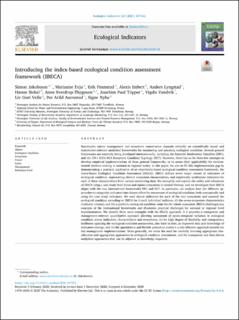| dc.contributor.author | Jakobsson, Simon | |
| dc.contributor.author | Evju, Marianne | |
| dc.contributor.author | Framstad, Erik | |
| dc.contributor.author | Imbert, Alexis | |
| dc.contributor.author | Lyngstad, Anders | |
| dc.contributor.author | Sickel, Hanne | |
| dc.contributor.author | Sverdrup-Thygeson, Anne | |
| dc.contributor.author | Töpper, Joachim Paul | |
| dc.contributor.author | Vandvik, Vigdis | |
| dc.contributor.author | Velle, Liv Guri | |
| dc.contributor.author | Aarrestad, Per Arild | |
| dc.contributor.author | Nybø, Signe | |
| dc.date.accessioned | 2021-07-19T12:17:33Z | |
| dc.date.available | 2021-07-19T12:17:33Z | |
| dc.date.created | 2021-02-11T11:02:12Z | |
| dc.date.issued | 2021-05 | |
| dc.identifier.citation | Jakobsson, S., Evju, M., Framstad, E., Imbert, A., Lyngstad, A., Sickel, H., Sverdrup-Thygeson, A., Töpper, J. P., Vandvik, V., Velle, L. G., Aarrestad, P. A., & Nybø, S. (2021). Introducing the index-based ecological condition assessment framework (IBECA). Ecological Indicators, 124, 12. | en_US |
| dc.identifier.issn | 1470-160X | |
| dc.identifier.uri | https://hdl.handle.net/11250/2764777 | |
| dc.description.abstract | Sustainable nature management and ecosystem conservation depends critically on scientifically sound and stakeholder-relevant analytical frameworks for monitoring and assessing ecological condition. Several general frameworks are currently being developed internationally, including the Essential Biodiversity Variables (EBV), and the UN’s SEEA EEA Ecosystem Condition Typology (ECT). However, there has so far been few attempts to develop empirical implementations of these general frameworks, or to assess their applicability for environmental decision-making at national or regional scales. In this paper, we aim to fill this implementation gap by demonstrating a practical application of an empirically-based ecological condition assessment framework, the Index-Based Ecological Condition Assessment (IBECA). IBECA defines seven major classes of indicators of ecological condition, representing distinct ecosystem characteristics, and empirically synthesizes indicators for each of these characteristics from various monitoring data. We exemplify and explore the utility and robustness of IBECA using a case study from forest and alpine ecosystems in central Norway, and we investigate how IBECA aligns with the two international frameworks EBV and ECT. In particular, we analyze how the different approaches to categorize indicators into classes affect the assessment of ecological condition, both conceptually and using the case study indicators. We used eleven indicators for each of the two ecosystems and assessed the ecological condition according to IBECA for i) each individual indicator, ii) the seven ecosystem characteristics (indicator classes), and iii) a synthetic ecological condition value for the whole ecosystem. IBECA challenges key concepts of the international frameworks and illustrates practical challenges for national or regional level implementation. We identify three main strengths with the IBECA approach: i) it provides a transparent and management-relevant quantitative approach allowing assessment of spatio-temporal variation in ecological condition across indicators, characteristics and ecosystems, ii) the high degree of flexibility and transparency facilitates updating the ecological condition assessments, also back in time, as improved data and knowledge of indicators emerge, and iii) the quantitative and flexible procedure makes it a cost-effective approach suitable for fast management implementations. More generally, we stress the need for carefully choosing appropriate classification and aggregation approaches in ecological condition assessments, and for transparent and data-driven analytical approaches that can be adjusted as knowledge improves. | en_US |
| dc.language.iso | eng | en_US |
| dc.publisher | Elsevier Ltd. | en_US |
| dc.rights | Navngivelse 4.0 Internasjonal | * |
| dc.rights.uri | http://creativecommons.org/licenses/by/4.0/deed.no | * |
| dc.title | Introducing the index-based ecological condition assessment framework (IBECA) | en_US |
| dc.type | Peer reviewed | en_US |
| dc.type | Journal article | en_US |
| dc.description.version | publishedVersion | en_US |
| dc.rights.holder | © 2020 The Author(s) | en_US |
| dc.source.volume | 124 | en_US |
| dc.source.journal | Ecological Indicators | en_US |
| dc.identifier.doi | 10.1016/j.ecolind.2020.107252 | |
| dc.identifier.cristin | 1888790 | |
| dc.source.articlenumber | 107252 | en_US |
| cristin.ispublished | true | |
| cristin.fulltext | original | |
| cristin.qualitycode | 1 | |

